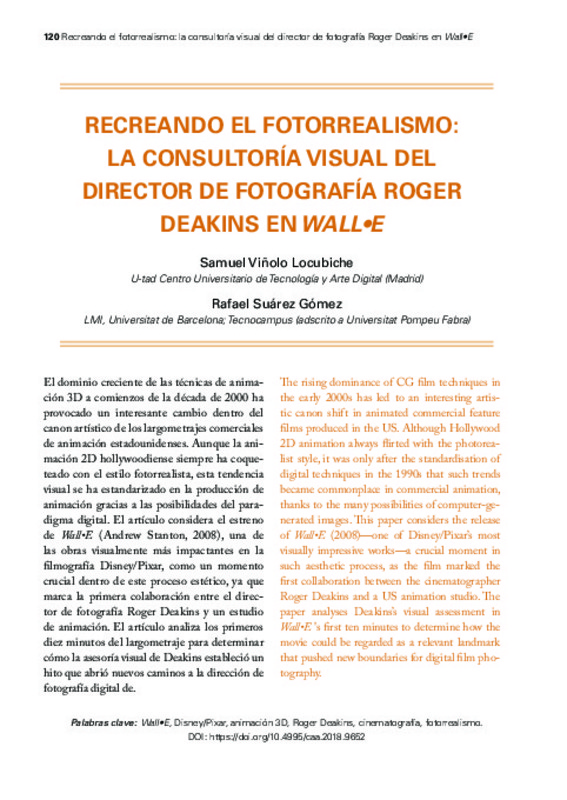JavaScript is disabled for your browser. Some features of this site may not work without it.
Buscar en RiuNet
Listar
Mi cuenta
Estadísticas
Ayuda RiuNet
Admin. UPV
Recreando el fotorrealismo: la consultoría visual del director de fotografía Roger Deakins en Wall-E
Mostrar el registro sencillo del ítem
Ficheros en el ítem
| dc.contributor.author | Viñolo Locubiche, Samuel
|
es_ES |
| dc.contributor.author | Suárez Gómez, Rafael
|
es_ES |
| dc.date.accessioned | 2018-04-11T09:33:36Z | |
| dc.date.available | 2018-04-11T09:33:36Z | |
| dc.date.issued | 2018-03-01 | |
| dc.identifier.issn | 2173-6049 | |
| dc.identifier.uri | http://hdl.handle.net/10251/100176 | |
| dc.description.abstract | [EN] The rising dominance of CG film techniques in the early 2000s has led to an interesting artistic canon shift in animated commercial feature films produced in the US. Although Hollywood 2D animation always flirted with the photorealist style, it was only after the standardisation of digital techniques in the 1990s that such trends became commonplace in commercial animation, thanks to the many possibilities of computer-generated images. This paper considers the release of Wall•E (2008)—one of Disney/Pixar’s most visually impressive works—a crucial moment in such aesthetic process, as the film marked the first collaboration between the cinematographer Roger Deakins and a US animation studio. The paper analyses Deakins’s visual assessment in Wall•E 's first ten minutes to determine how the movie could be regarded as a relevant landmark that pushed new boundaries for digital film photography. | es_ES |
| dc.description.abstract | [ES] El dominio creciente de las técnicas de animación 3D a comienzos de la década de 2000 ha provocado un interesante cambio dentro del canon artístico de los largometrajes comerciales de animación estadounidenses. Aunque la animación 2D hollywoodiense siempre ha coqueteado con el estilo fotorrealista, esta tendencia visual se ha estandarizado en la producción de animación gracias a las posibilidades del paradigma digital. El artículo considera el estreno de Wall•E (Andrew Stanton, 2008), una de las obras visualmente más impactantes en la filmografía Disney/Pixar, como un momento crucial dentro de este proceso estético, ya que marca la primera colaboración entre el director de fotografía Roger Deakins y un estudio de animación. El artículo analiza los primeros diez minutos del largometraje para establecer si la labor de asesoría visual de Deakins pueden considerarse un hito que abrió nuevos caminos a la dirección de fotografía digital de imagen real. | es_ES |
| dc.language | Español | es_ES |
| dc.publisher | Universitat Politècnica de València | |
| dc.relation.ispartof | Con A de Animación | |
| dc.rights | Reconocimiento - No comercial - Sin obra derivada (by-nc-nd) | es_ES |
| dc.subject | Wall•E | es_ES |
| dc.subject | Disney/Pixar | es_ES |
| dc.subject | Animación 3D | es_ES |
| dc.subject | Roger Deakins | es_ES |
| dc.subject | Cinematografía | es_ES |
| dc.subject | Fotorrealismo | es_ES |
| dc.subject | CG Animation | es_ES |
| dc.subject | Cinematography | es_ES |
| dc.subject | Photorealism | es_ES |
| dc.title | Recreando el fotorrealismo: la consultoría visual del director de fotografía Roger Deakins en Wall-E | es_ES |
| dc.type | Artículo | es_ES |
| dc.date.updated | 2018-04-10T12:42:07Z | |
| dc.identifier.doi | 10.4995/caa.2018.9652 | |
| dc.rights.accessRights | Abierto | es_ES |
| dc.description.bibliographicCitation | Viñolo Locubiche, S.; Suárez Gómez, R. (2018). Recreando el fotorrealismo: la consultoría visual del director de fotografía Roger Deakins en Wall-E. Con A de Animación. (8):120-134. https://doi.org/10.4995/caa.2018.9652 | es_ES |
| dc.description.accrualMethod | SWORD | es_ES |
| dc.relation.publisherversion | https://doi.org/10.4995/caa.2018.9652 | es_ES |
| dc.description.upvformatpinicio | 120 | es_ES |
| dc.description.upvformatpfin | 134 | es_ES |
| dc.type.version | info:eu-repo/semantics/publishedVersion | es_ES |
| dc.description.issue | 8 | |
| dc.identifier.eissn | 2173-3511 | |
| dc.description.references | GUNNING, Tom, 2007. "Moving Away from the Index: Cinema and the Impression of Reality", en Differences: A Journal of Feminist Cultural Studies, Brown University, 18, pp. 29-52. | es_ES |
| dc.description.references | VIÑOLO, Samuel, DURAN, Jaume, 2013. "Entre lo siniestro y lo subversivo. Categorías estéticas del cine de animación híbrido" en Archivos de la Filmoteca, nº. 72 (2013), pp. 37-49. | es_ES |








